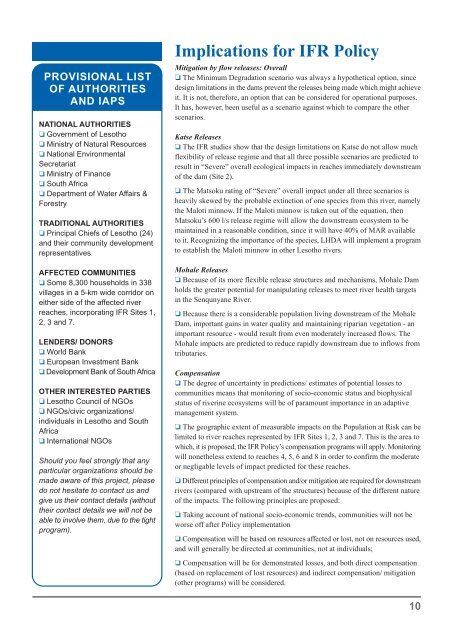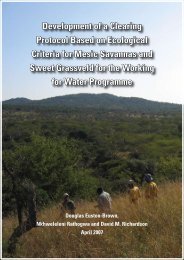INFORMATION DOCUMENT - DWA Home Page
INFORMATION DOCUMENT - DWA Home Page
INFORMATION DOCUMENT - DWA Home Page
Create successful ePaper yourself
Turn your PDF publications into a flip-book with our unique Google optimized e-Paper software.
PROVISIONAL LIST<br />
OF AUTHORITIES<br />
AND IAPS<br />
NATIONAL AUTHORITIES<br />
❏ Government of Lesotho<br />
❏ Ministry of Natural Resources<br />
❏ National Environmental<br />
Secretariat<br />
❏ Ministry of Finance<br />
❏ South Africa<br />
❏ Department of Water Affairs &<br />
Forestry<br />
TRADITIONAL AUTHORITIES<br />
❏ Principal Chiefs of Lesotho (24)<br />
and their community development<br />
representatives<br />
AFFECTED COMMUNITIES<br />
❏ Some 8,300 households in 338<br />
villages in a 5-km wide corridor on<br />
either side of the affected river<br />
reaches, incorporating IFR Sites 1,<br />
2, 3 and 7.<br />
LENDERS/ DONORS<br />
❏ World Bank<br />
❏ European Investment Bank<br />
❏ Development Bank of South Africa<br />
OTHER INTERESTED PARTIES<br />
❏ Lesotho Council of NGOs<br />
❏ NGOs/civic organizations/<br />
individuals in Lesotho and South<br />
Africa<br />
❏ International NGOs<br />
Should you feel strongly that any<br />
particular organizations should be<br />
made aware of this project, please<br />
do not hesitate to contact us and<br />
give us their contact details (without<br />
their contact details we will not be<br />
able to involve them, due to the tight<br />
program).<br />
Implications for IFR Policy<br />
Mitigation by flow releases: Overall<br />
❏ The Minimum Degradation scenario was always a hypothetical option, since<br />
design limitations in the dams prevent the releases being made which might achieve<br />
it. It is not, therefore, an option that can be considered for operational purposes.<br />
It has, however, been useful as a scenario against which to compare the other<br />
scenarios.<br />
Katse Releases<br />
❏ The IFR studies show that the design limitations on Katse do not allow much<br />
flexibility of release regime and that all three possible scenarios are predicted to<br />
result in “Severe” overall ecological impacts in reaches immediately downstream<br />
of the dam (Site 2).<br />
❏ The Matsoku rating of “Severe” overall impact under all three scenarios is<br />
heavily skewed by the probable extinction of one species from this river, namely<br />
the Maloti minnow. If the Maloti minnow is taken out of the equation, then<br />
Matsoku’s 600 l/s release regime will allow the downstream ecosystem to be<br />
maintained in a reasonable condition, since it will have 40% of MAR available<br />
to it. Recognizing the importance of the species, LHDA will implement a program<br />
to establish the Maloti minnow in other Lesotho rivers.<br />
Mohale Releases<br />
❏ Because of its more flexible release structures and mechanisms, Mohale Dam<br />
holds the greater potential for manipulating releases to meet river health targets<br />
in the Senqunyane River.<br />
❏ Because there is a considerable population living downstream of the Mohale<br />
Dam, important gains in water quality and maintaining riparian vegetation - an<br />
important resource - would result from even moderately increased flows. The<br />
Mohale impacts are predicted to reduce rapidly downstream due to inflows from<br />
tributaries.<br />
Compensation<br />
❏ The degree of uncertainty in predictions/ estimates of potential losses to<br />
communities means that monitoring of socio-economic status and biophysical<br />
status of riverine ecosystems will be of paramount importance in an adaptive<br />
management system.<br />
❏ The geographic extent of measurable impacts on the Population at Risk can be<br />
limited to river reaches represented by IFR Sites 1, 2, 3 and 7. This is the area to<br />
which, it is proposed, the IFR Policy’s compensation programs will apply. Monitoring<br />
will nonetheless extend to reaches 4, 5, 6 and 8 in order to confirm the moderate<br />
or negligable levels of impact predicted for these reaches.<br />
❏ Different principles of compensation and/or mitigation are required for downstream<br />
rivers (compared with upstream of the structures) because of the different nature<br />
of the impacts. The following principles are proposed:<br />
❏ Taking account of national socio-economic trends, communities will not be<br />
worse off after Policy implementation<br />
❏ Compensation will be based on resources affected or lost, not on resources used,<br />
and will generally be directed at communities, not at individuals;<br />
❏ Compensation will be for demonstrated losses, and both direct compensation<br />
(based on replacement of lost resources) and indirect compensation/ mitigation<br />
(other programs) will be considered.<br />
10
















